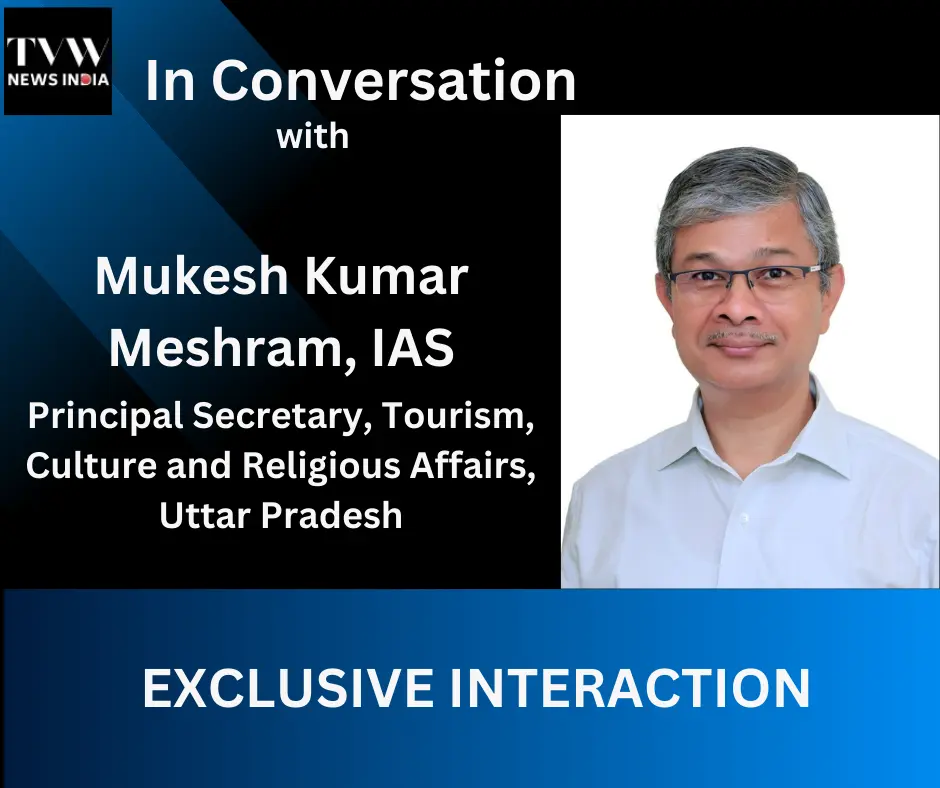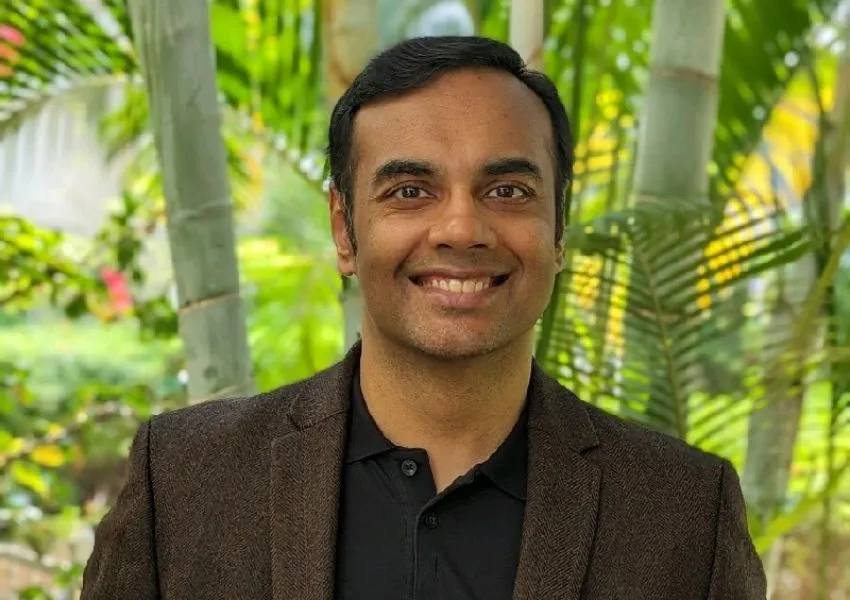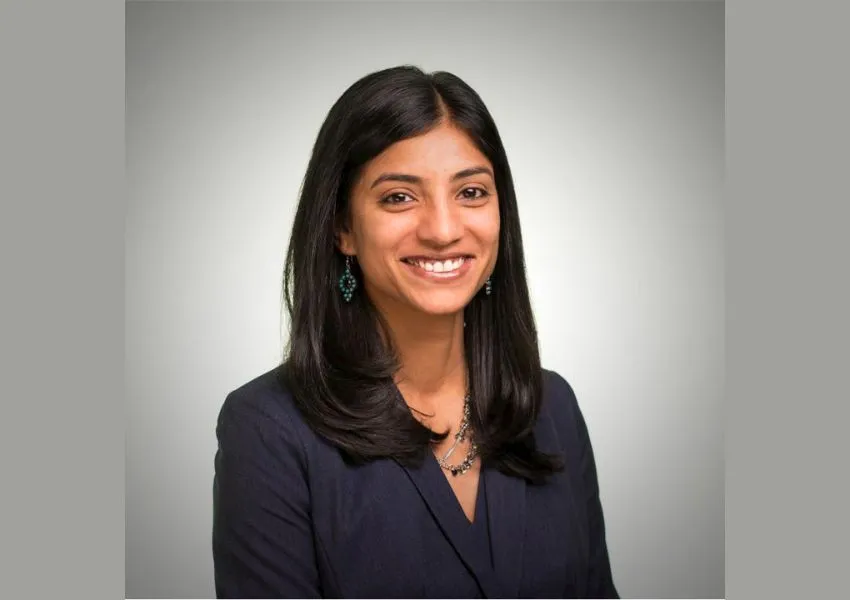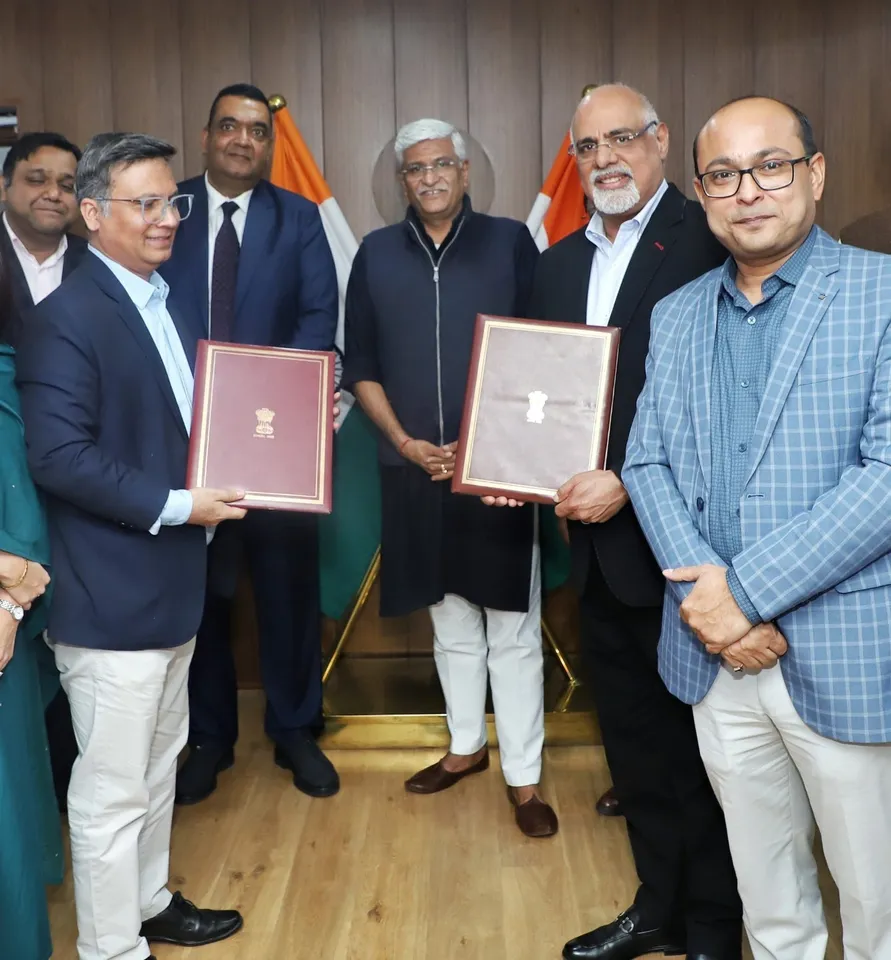In an in-depth discussion with Mr. Mukesh Kumar Meshram, the esteemed senior IAS officer of the Uttar Pradesh Cadre currently serving as the Principal Secretary of the Tourism and Culture Department and the Director General of UP Tourism, we delved into the remarkable achievements of UP Tourism under his dynamic leadership. Mr. Meshram shared insights into his motivations for joining the Indian Administrative Service (IAS) and how his extensive experience across various government roles has shaped his strategic approach to policy-making and administration. Reflecting on his journey, he highlighted his profound desire to contribute to society and play a pivotal role in policy formulation for nation-building and development. His hands-on experience in various districts of Uttar Pradesh and his involvement in policy formulation across departments like Ayush, PWD, and LDA have been instrumental in his ability to develop and implement inclusive and effective policies.
Under Mr. Meshram’s leadership, the U.P. Tourism Department has recently adopted international standards for tourist surveys, significantly enhancing the understanding of the tourism landscape and contributing to the development of strategic policies aimed at positioning Uttar Pradesh as a premier tourist destination. Additionally, the state has seen a surge in religious tourism, particularly in Varanasi and Ayodhya, driven by improved infrastructure, increased connectivity, and extensive promotional efforts. The government’s commitment to sustainable and responsible tourism practices, along with the development of iconic tourism circuits and public-private partnerships, is paving the way for Uttar Pradesh to emerge as a leading global tourist destination.
Here is the full interview:
What motivated you to join the Indian Administrative Service (IAS), and how has your extensive experience across different government roles shaped your strategic approach to policy-making and administration?
My motivation to join the IAS stemmed from a profound desire to contribute to society and play a pivotal role in policy formulation for nation-building and development. The IAS, being a premier service in Indian bureaucracy, offers unparalleled opportunities to work in diverse fields, including tourism, which has always intrigued me. Throughout my extensive career in different government organizations, I have gained invaluable insights and honed my strategic approach to policy-making and administration. My initial field-level experience in various districts of Uttar Pradesh as SDM, CDO, DM, and Divisional Commissioner allowed me to connect directly with the people, understanding their ground realities and problems. This hands-on experience has been instrumental in shaping my ability to address the issues faced by common citizens effectively. Understanding the critical role of revenue and financial resources in socio-economic development, I have been actively involved with State GST and served as a member of the drafting committee of the GST Act. This experience has equipped me with a deep understanding of the financial underpinnings necessary for sustainable development. Moreover, my involvement in policy formulation and administrative decisions across various departments, including Ayush, PWD, and LDA, has provided me with a comprehensive perspective on governance and development. Each role has contributed to my ability to develop and implement policies that are not only effective but also inclusive and responsive to the needs of the populace. In summary, my journey in the IAS has been driven by a commitment to societal betterment and a strategic approach shaped by diverse and enriching experiences across multiple government roles.
The U.P. Tourism Department recently adopted international standards for tourist surveys. Can you elaborate on the key changes this adoption has brought about? Also, what are the primary goals you aim to achieve with the implementation of these new survey standards?
The current survey methodology employed in our state aligns with the guidelines established by the Ministry of Tourism, Government of India. However, to gain a more comprehensive understanding of the tourism landscape, the new survey will incorporate a refined classification system to distinguish between leisure, business, casual, and cultural tourists. Additionally, it will collect detailed economic data to accurately assess the tourism sector’s contribution to the state’s Gross State Domestic Product (GSDP). The primary objective of this enhanced survey methodology is to gather precise and reliable tourist footfall data. These insights will serve as a cornerstone for developing strategic policies and initiatives aimed at positioning Uttar Pradesh as a premier tourist destination, attracting both domestic and international visitors.
How will the insights gained from these surveys influence the future tourism strategies and policies in Uttar Pradesh? Can you share any preliminary findings or trends that have emerged from the recent surveys conducted under these new standards?
These insights will be invaluable in guiding our strategic planning and investment decisions. By identifying areas with high potential, prioritizing infrastructure development, and effectively allocating marketing resources, we can optimize the state’s tourism offerings. Additionally, the data will empower us to promote lesser-known destinations, diversify tourism experiences, and address overcrowding at popular sites, fostering sustainable tourism practices. Understanding visitor demographics and preferences will enable us to position Uttar Pradesh as a competitive and sustainable tourism destination. This data-driven approach will facilitate benchmarking against other regions, attracting international tourists, and integrating into global tourism networks. As you know, comprehensive surveys require adequate time for data collection and analysis. Our tourist footfall survey is a 13-month endeavor that commenced in June 2024. Therefore, it would be very early to comment on specific insights at this stage.
Religious tourism in Uttar Pradesh, especially in Varanasi and Ayodhya, is expected to surpass traditional hotspots like Goa and Agra. What factors are driving this growth, and how is the state managing the influx while preserving the sites’ sanctity and heritage? Additionally, what infrastructure developments are planned to accommodate more visitors?
The growth in religious tourism in Uttar Pradesh, especially in Varanasi and Ayodhya, is driven by improved infrastructure, increased connectivity, and extensive promotional efforts. The state’s rich cultural and spiritual heritage also plays a significant role. To manage the influx while preserving the sanctity and heritage of these sites, the state implements strict regulations, ensures proper site maintenance, and promotes responsible tourism. Planned infrastructure developments include upgraded roads, enhanced public transportation, and expanded accommodation options. Projects like the Ayodhya Master Plan 2031 focus on comprehensive development, ensuring that the influx of tourists is managed effectively and the integrity of these sacred sites is maintained. Uttar Pradesh is fast emerging as “India’s Most Favored Tourism Destination,” both internationally and domestically. In 2022, the state witnessed an incredible surge in domestic tourist visits, totaling 32 crores, ranking it number one in India, while foreign tourist arrivals reached 6.5 lakhs, placing it fifth in the country. According to Niti Aayog, about 3 lakh tourists will be visiting Ayodhya daily, and an estimated 6.8 crores of tourists, both domestic and international, will visit Ayodhya by 2030. Jefferies, a brokerage firm, has recently estimated that a $10 billion makeover of Ayodhya, including a new airport, revamped railway station, township, and improved road connectivity, will likely drive a multiplier effect with new hotels and other economic activities, potentially attracting 50 million tourists annually. To provide world-class infrastructure facilities in the 6 Gate Complexes of Ayodhya, development is planned on a PPP mode for 60 years. Developers will develop tourism infrastructure such as an Integrated Transit Complex, including hotels, food courts, retail spaces, dormitories, petrol pumps/gas stations, health clinics, TFC, roads, essential services, and more. Efforts are also underway to develop and market other tourist destinations in Uttar Pradesh, such as Varanasi, Lucknow, and the Buddhist Circuit. By highlighting the state’s rich cultural and historical heritage, the government aims to attract tourists to lesser-known areas, balancing the tourism load and fostering economic development across the region. Training programs for local communities and stakeholders further support sustainable tourism growth and management.
Uttar Pradesh has immense tourism potential for global leadership. What steps are being taken to position UP as a leading global tourist destination, and how does the state plan to balance this growth with sustainable and responsible tourism practices?
Uttar Pradesh is taking several steps to position itself as a leading global tourist destination. These include developing iconic tourism circuits like the Ramayan Circuit and Buddhist Circuit, enhancing infrastructure, and promoting lesser-known destinations. The state invests in marketing campaigns targeting international audiences and collaborates with global tourism stakeholders. To balance growth with sustainable practices, UP emphasizes eco-tourism, supports local communities through initiatives like home-stays, and enforces regulations to preserve cultural and natural heritage. Training programs for locals in hospitality and sustainable tourism practices are also in place, ensuring responsible tourism development. The State Government is encouraging FDI in the tourism sector through investible projects. FDI in the tourism sector is already on the automatic route. Policy interventions such as the Uttar Pradesh Tourism Policy 2022 and Land Lease Policy 2024, along with the availability of a Government Land Bank in all districts, particularly Buddhist Heritage Sites, will encourage investments in developing new tourism projects such as hotels, resorts, convention facilities, eco-tourism, wellness tourism, heritage tourism, and other tourism assets. The Uttar Pradesh Tourism Policy has also made special provisions to create Focus Tourism Destinations in any part of the state that has the potential to become an Integrated Tourism Zone. Additional capital subsidies of up to 5%, with a maximum of 30%, can be provided to increase the economic viability of mega projects in the state. Under the State Tourism Policy 2022, a maximum capital subsidy of up to Rs 40 crore (USD 5 million) per project is permissible for investments exceeding Rs 500 crore (USD 60 million).
Various initiatives have been taken to boost eco-tourism and rural tourism, such as:
- The formation of an Eco-Tourism Board to monitor responsible, safe, sustainable, and eco-friendly tourism initiatives while creating synergies between relevant stakeholder departments to bolster rural, wildlife, agrotourism, and adventure tourism.
- The identification of rural tourism clusters and the setup of district tourism promotion councils to maintain and preserve the various attractions of the district- mythological, historical, cultural heritage, and traditions- protecting and promoting them.
- The development of new and unique travel experiences showcasing the state’s unique offerings- crafts tourism, agro-tourism, village homestays
What are some of the biggest challenges you face in promoting Uttar Pradesh as a top tourist destination, and how are you addressing them? Additionally, how does the state plan to improve connectivity and accessibility to less-known but culturally significant tourist spots?
Promoting Uttar Pradesh as a top tourist destination involves challenges such as managing infrastructure development, preserving cultural heritage, and ensuring sustainable tourism practices. Addressing these challenges involves investing in infrastructure upgrades, including better roads and transportation networks. The state is also implementing conservation measures to protect cultural sites and promote eco-friendly practices. To improve connectivity and accessibility to lessknown but culturally significant spots, Uttar Pradesh plans to enhance regional transportation, develop tourism circuits that link hidden gems, and increase digital marketing to raise awareness. Partnerships with local communities and stakeholders further support these efforts, ensuring comprehensive and balanced tourism growth.
What are your priorities for the future development of tourism in Uttar Pradesh over the next five years, and how do you see the role of public-private partnerships evolving in the tourism sector?
Over the next five years, the priorities for tourism development in Uttar Pradesh include expanding and enhancing infrastructure, promoting lesser-known destinations, and integrating sustainable practices into tourism strategies. Key focus areas are developing iconic tourism circuits, improving connectivity, and preserving cultural and natural heritage. Public-private partnerships are expected to play a crucial role, with increased collaboration between the government and private sector to invest in infrastructure, manage tourist sites, and deliver high-quality services. These partnerships will drive innovation, attract investment, and ensure that tourism growth benefits both local communities and visitors.
- The Uttar Pradesh Tourism department is preparing master plans for all the major Buddhist heritage destinations to facilitate structured investments in public and private projects.
- Through the PPP policy, around 33 wayside amenities are being transferred to the private sector for the development of new hotels, resorts, and other tourism projects on long-term concession and lease basis of 60 years. · The Tourism department has launched the Uttar Pradesh Land Lease Policy 2024 to facilitate faster allotment of land parcels for an enhanced lease period of up to 90 years.
- Selected heritage properties are being developed into tourism assets through private sector participation, with properties leased for a maximum of 90 years.
- To promote faster modes of travel, eight heliports are being developed on a concession and lease basis for a maximum period of 60 years.
These efforts aim to diversify tourism offerings, create jobs, and foster sustainable economic growth across the state.
Note: We are also on WhatsApp, LinkedIn, and YouTube, to get the latest news updates, Join our Channels. WhatsApp– Click here, and for LinkedIn– Click Here.














